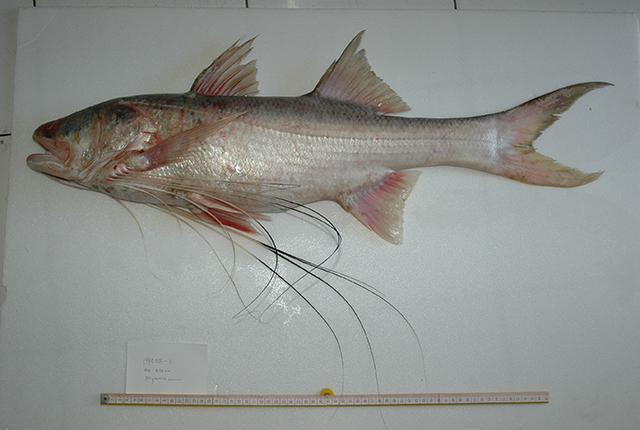| Polynemidae (Threadfins) |
| 72 cm SL (male/unsexed) |
|
pelagic; freshwater; depth range 3 - 5 m |
| Asia: Malaysia, Borneo. Currently known only from the mouth of the Batang Lupar River, Borneo, Malaysia (Ref. 83753). |
|
Dorsal spines (total): 9; Dorsal soft rays (total): 13; Anal spines: 3; Anal soft rays: 11. A species of Polydactylus that differs from all of its congeners by the following combination of characters: 8 dorsal-fin spines, first spine tiny, second spine very strong (its width more than 5 times of width of remaining spines); 13 second dorsal-fin soft rays; 11 anal-fin soft rays; 12 pectoral-fin rays, its length 22–24% (mean 23%) of SL, posterior tip not reaching a vertical through posterior tip of depressed pelvic fin; 6 pectoral filaments, fourth or fifth filament longest, its length 77–85% (mean 81%) of SL, posterior tip extending slightly beyond caudal-fin base; pored lateral-lined scales 67–75 (mean 71); lateral line unbranched, extending onto upper end of lower caudal-fin lobe; 6 scale rows above lateral line, 8 below; 14 gill rakers on upper limb, 18 on lower limb, 32 in total; occipital profile concave; posterior margin of maxilla extending considerably beyond a vertical through posterior margin of adipose eyelid; depth of posterior margin of maxilla 4–5% (mean 5%) of SL, greater than orbit diameter; well-developed swimbladder present; basal half of third to sixth pectoral filament white, becoming black distally. Polydactylus luparensis can be easily distinguished from all Indo-Pacific congeners by having the black distal half of the third to sixth pectoral filaments (whitish in the latter). Only two other taxa, Polynemus melanochir dulcis Motomura & Sabaj, 2002 and P. melanochir melanochir Valenciennes in Cuvier & Valenciennes, 1831, in the family Polynemidae have the black pectoral filaments (Motomura & Sabaj, 2002; Motomura, 2004b) (Ref. 83753). |
| Inhabiting turbid brackish water. The species is abundant in the river mouth especially from June to August and mainly caught by gill nets. Juveniles have also been observed in the same place (local fishermen, pers. comm.) (Ref. 83753). |
|
Data deficient (DD); Date assessed: 21 June 2018 Ref. (130435)
|
| harmless |
Source and more info: www.fishbase.org. For personal, classroom, and other internal use only. Not for publication.
